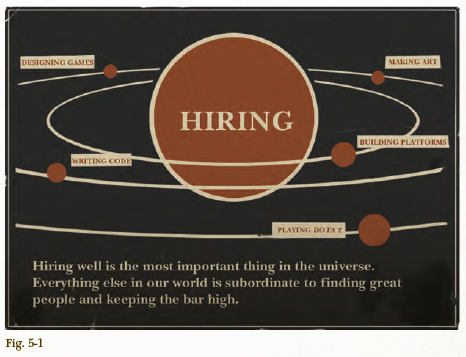Valve Software’s Success Linked Strongly to Hiring Practices
Valve Software is one of the videogaming industry’s most prominent and successful companies. It is responsible for some of videogaming’s most prominent games and game platforms, including Half-Life, Team Fortress, Counterstrike, Half-Life 2, Portal, and Left 4 Dead. They also run the enormously popular Steam digital game distribution system, which allows PC gamers to purchase and download traditional retail and indie games. The company has a reputation for innovation and creativity, which is quite far from the reputation of other major players in the videogame industry, like publishing behemoth Electronic Arts.
Last week, someone leaked the New Employee Handbook from Valve, and it provides a fascinating glimpse into the structure of this enormously popular company. Contrary to how many videogame developers are structured, Valve is almost a 100% flat organization, despite boasting nearly 300 employees. Here’s what the handbook says:
That’s why Valve is flat. It’s our shorthand way of saying that we don’t have any management, and nobody “reports to” anybody else. We do have a founder/president, but
even he isn’t your manager. This company is yours to steer—toward opportunities and away from risks. You have the power to green-light projects. You have the power to
ship products.
In many ways, it’s the job characteristics model at its logical conclusion: complete and absolute autonomy, variety, identity, significance, and feedback for every employee. Each employee decides the projects s/he will work on (autonomy). If they get bored with one project, they can instantly switch to another with no job-related consequences (variety). Each employee tries to gain support from coworkers to work on their personal projects (feedback), which then can be brought to fruition with sufficient effort (identity, significance).
Commentary among videogame blogs on this approach has been mixed, with some suggesting that this approach could never work with other companies. Outside of videogaming and other creative enterprises, that’s probably true. Videogame development is itself essentially a creative process. If a product doesn’t ship on time, the company may lose money, but it is unlikely to lose clients. Players will buy the game regardless of when it comes out, as long as it is of high quality. And quality is clearly a major objective at Valve. The attitude toward how employees spend their time is quite clear in this statement on what happens when employees make mistakes:
Screwing up is a great way to find out that your assumptions were wrong or that your model of the world was a little bit off. As long as you update your model and move forward with a better picture, you’re doing it right. Look for ways to test your beliefs. Never be afraid to run an experiment or to collect more data.
For Valve, spending more time is always justified if it means you’ll do a better job. A management system like this in a service organization could falter easily; imagine a project due for a client tomorrow only for your coworker to say, “I’ve decided to drop this project; you’ll need to find someone else.” In videogame development, this is still a roadblock, but it does not grind business to a halt.
One might think that this everyone-runs-the-organization kind of approach would be risky. And to some extent, that’s true – Valve even admits it:
So if every employee is autonomously making his or her own decisions, how is that not chaos? How does Valve make sure that the company is heading in the right direction? When everyone is sharing the steering wheel, it seems natural to fear that one of us is going to veer Valve’s car off the road.
The key to solving this problem is finding excellent people to work at your company. And this is clearly objective #1 at Valve:
Hiring well is the most important thing in the universe. Nothing else comes close. It’s more important than breathing. So when you’re working on hiring—participating in an interview loop or innovating in the general area of recruiting—everything else you could be doing is stupid and should be ignored!
Valve goes so far as to encourage new employees to take part in the interview process immediately after they themselves were hired, so that they can get a better sense of the kind of traits valuable to success at Valve. The interview process is not explained in much detail, however the discussion makes it clear that it is structured and carefully thought out. The hiring process actually echoes some sentiments well-explored in I/O Psychology:
Hiring is fundamentally the same across all disciplines. There are not different sets of rules or criteria for engineers, artists, animators, and accountants. Some details are different—like, artists and writers show us some of their work before coming in for an interview. But the actual interview process is fundamentally the same no matter who we’re talking to.
The key at Valve, as in all good selection processes, it to identify qualified individuals who fit with the company. It also only hires the very best:
In these conditions, hiring someone who is at least capable seems (in the short term) to be smarter than not hiring anyone at all. But that’s actually a huge mistake. We can always bringon temporary/contract help to get us through tough spots, but we should never lower the hiring bar.
The company is 100% focused on recruiting and selecting a committed, high performing workforce. It keeps its selection ratio as low as possible – even if there is more work to do than there are employees – to ensure that the permanent employees it retains are excellent and unlikely to bring the company crashing down around them.
| Previous Post: | SIOP 2012: Day 3 Live-Blog |
| Next Post: | Grad School: Should I Get a Traditional or Online I/O Master’s/Ph.D.? |
